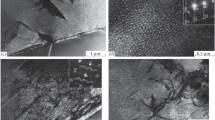Abstract
The stress corrosion cracking (SCC) characteristics of α-titanium sheets in a bromine-methanol solution have been studied in the annealed and cold-rolled conditions using longitudinal and transverse specimens. The times to failure for annealed longitudinal specimens were longer than those for similarly tested transverse specimens. The cold-rolled specimens developed resistance to SCC, but failed by cleavage when notched, unlike the intergranular separation in annealed titanium. The apparent activation energy was found to be texture dependent and was in the range 30 to 51 kJ mol−1 for annealed titanium, and 15kJ mol−1 for cold-rolled titanium. The dependence of SCC behaviour on the texture is related to the changes in the crack initiation times. These are caused by changes in the passivation and repassivation characteristics of the particular thickness plane. The thickness planes are identified with the help of X-ray pole figures obtained on annealed and cold-rolled material. On the basis of the activation energy and the electrochemical measurements, the mechanism of SCC in annealed titanium is identified to be the one involving stress-aided anodic dissolution. On the other hand, the results on the cold-rolled titanium are in support of the hydrogen embrittlement mechanism consisting of hydride precipitation. The cleavage planes identified from the texture data match with the reported habit planes for hydride formation.
Similar content being viewed by others
References
M. J. Blackburn, J. A. Feeny and T. R. Beck, “Advances in Corrosion Science and Technology”, Vol. 3 (Plenum Press, New York, 1973) p. 67.
A. J. Sedriks, J. A. S. Green and P. W. Slattery, Corrosion 24 (1968) 172.
A. J. Sedriks and J. A. S. Green ibid 25 (1969) 324.
T. R. Beck, in “The Theory of Stress Corrosion Cracking in Alloys” edited by J. C. Scully (Maney, UK, 1971) p. 64.
J. Spurrier and J. C. Scully, Corrosion 28 (1972) 453.
J. Brettle, Metals and Materials 6 (1972) 442.
R. J. H. Wanhill, Acta Met. 21 (1973) 1253.
F. Larson and A. Zarkades, “Properties of Textured Titanium Alloys”, MCIC-74-20, Battelle Columbus Laboratory, Columbus, Ohio (1974).
D. N. Fager and W. F. Spurr, Trans. ASM Q. 61 (1968) 283.
R. R. Boyer and W. F. Spurr, Met. Trans. 9A (1978) 1443.
H. V. Sudhaker Nayak, K. I. Vasu and Y. V. R. K. Prasad, Scripta Met. 12 (1978) 869.
Idem, J. Electrochem. Soc. India 27 (1978) 95.
A. I. Vogel, “A Text Book of Quantitative Inorganic Analysis”, 3rd Edn. (E.L.B.S., London, 1964) p. 944.
L. G. Schulz, J. Appl. Phys. 20 (1949) 1030.
C. J. McMahon, Jr and D. J. Traux, Corrosion 29 (1973) 47.
J. A. S. Green, ibid. 30 (1974) 175.
H. S. Rosenbaum, “Deformation Twinning” (Gordon and Breach, New York, 1964) p. 43.
M. J. Blackburn and W. H. Smyrl, “Titanium Science and Technology”, Vol. 4 (Plenum Press, New York, 1973) p. 2577.
E. G. Haney, R. Goldberg, R. Ernsberger and W. T. Brehm, Rept. No. 2 (NGR-39-008-014), Mellon Institute (1967).
T. P. Hoar and J. West, Proc. Roy. Soc. A268 (1962) 304.
T. P. Hoar, in “The Theory of Stress Corrosion Cracking in Alloys” edited by J. C. Scully (Maney, UK, 1971) p. 105.
D. T. Powell and J. C. Scully, Corrosion 25 (1969) 483.
I. W. Hall, Met. Trans. 9A (1978) 815.
G. Sanderson and J. C. Scully, Trans. AIME 239 (1967) 1883.
J. D. Boyd, Trans. ASM 62 (1969) 971.
T. S. Liu and M. A. Steinberg, ibid 50 (1958) 455.
I. Aitchison and B. Cox, Corrosion 28 (1972) 83.
Author information
Authors and Affiliations
Rights and permissions
About this article
Cite this article
Sudhaker Nayak, H.V., Vasu, K.I. & Prasad, Y.V.R.K. Texture dependent stress corrosion failure of commercial titanium sheets in bromine-methanol solution. J Mater Sci 15, 1265–1275 (1980). https://doi.org/10.1007/BF00551816
Received:
Accepted:
Issue Date:
DOI: https://doi.org/10.1007/BF00551816




